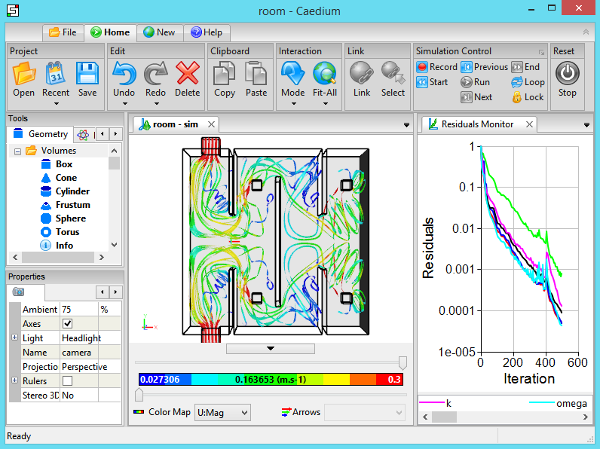
Get Started With CFD
New to Computational Fluid Dynamics (CFD)? Then you've come to the right place. Becoming productive in CFD can be a daunting task. However, as with all long term goals, if you break it down into smaller, achievable tasks, in no time you'll be up to speed and ready for production level work. Assuming you are familiar with the fluid dynamics of your application, then let's begin.
 CFD Simulation in Caedium
CFD Simulation in Caedium
Window Shopping
Before committing to a particular CFD package it is worth performing a 'lay-of-the-land' assessment. Check out online resources, such as videos, documentation, examples, and tutorials. Then ask yourself some basic questions:
- Will it simulate your particular application?
- Do the functions, processes, and interactions make sense to you?
- Is pricing inline with your budget?
If you answer in the negative to any of these questions, then it's time to move on and try another CFD vendor.
Kicking The Tires
Some CFD vendors offer time-limited free evaluations. Don't be shy, sign up and try some basic tutorials. Once you are familiar with the software, try to simulate simple versions (in terms of geometry and physics) of your target application. Remember this is supposed to be an evaluation, so trying to use a free trial to perform production work usually ends in frustration due to the time constraints and limited experience/knowledge.
The know-how to efficiently address your particular application with CFD is clearly valuable. That knowledge typically resides with the CFD vendor, at least initially. Most CFD vendors offer one-on-one support/consultancy services to accelerate your productivity, so if you are done with your evaluation period it's time to make the go, no-go purchase decision.
Test Drive
The first port of call for your full-on CFD effort should be some form of validation in support of your production work. You are looking for test cases (theory, experiment, or well regarded simulation) against which to compare/benchmark your own CFD results. At the same time you want to keep track of the turnaround time and computing resource requirements to achieve a given level of accuracy.
Often you will find that there is a trade-off between absolute accuracy and relative accuracy that still provides the correct trends between simulations. Throughout you should find that you can call on your CFD vendor to provide help and suggestions to best meet your goals.
Rubber Hits the Road
Given your validation effort you should be in a good position to make reasonable estimates of the computing resources and turnaround times for your production project. Also you should have confidence in your process to achieve your desired level of accuracy for your simulations.
One problem often found in production CFD is production geometry. If you are unfortunate enough to be given manufacturable geometry (including nuts and bolts) then it can be a frustrating task to make it simulation friendly. Removing extraneous details can be tedious and difficult. This is not only an issue for CFD but other CAE tools including FEA. Your first option is to try and influence your upstream geometry provider and suggest that details are better left off until the geometry lines are formerly frozen, which should be after the CFD round of the project - or else what's the point of CFD? Alternatively you could consider creating specific geometry to satisfy your CFD simulation needs. Your CFD vendor will also most likely have some ideas and suggestions on how best to configure the geometry for ease of simulation.
Post Mortem
Hopefully having demonstrated the effectiveness of CFD in your first project you are now well placed to make CFD a valued component of subsequent projects. There were likely aspects of the CFD process that went well and other aspects that did not, so after each project it's a good idea to do a review to see how you might make improvements.
Now you're ready for the next time CFD is called to arms.
Recent blog posts
- CFD Simulates Distant Past
- Background on the Caedium v6.0 Release
- Long-Necked Dinosaurs Succumb To CFD
- CFD Provides Insight Into Mystery Fossils
- Wind Turbine Design According to Insects
- Runners Discover Drafting
- Wind Tunnel and CFD Reveal Best Cycling Tuck
- Active Aerodynamics on the Lamborghini Huracán Performante
- Fluidic Logic
- Stonehenge Vortex Revealed as April Fools' Day Distortion Field
